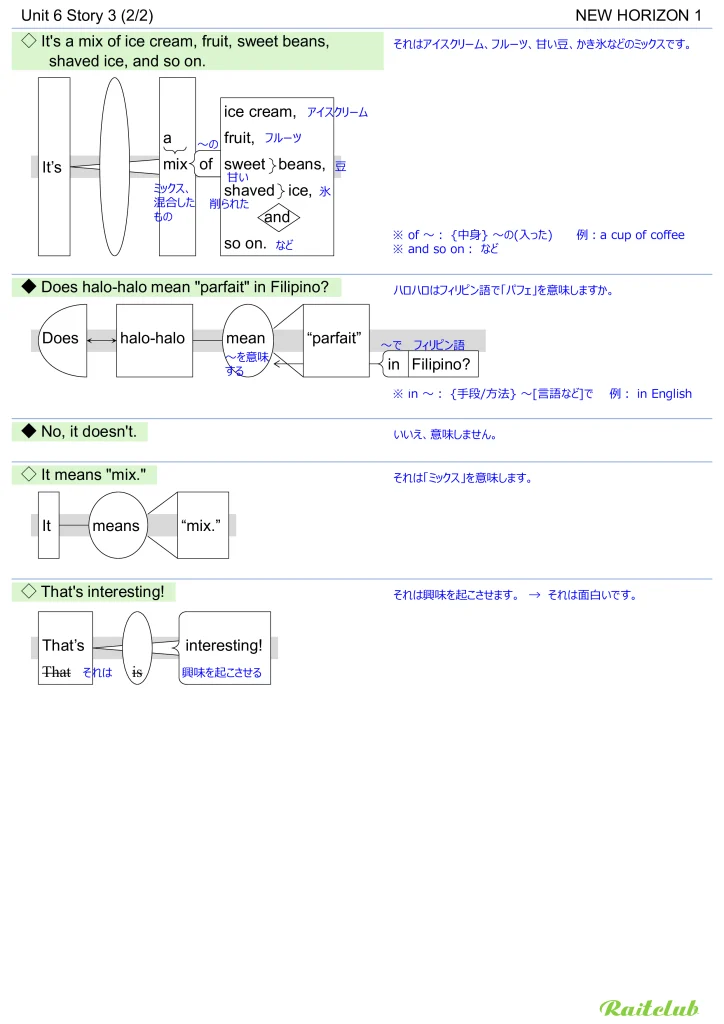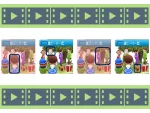中学1年生教科書 New Horizon 1 (ニューホライズン 1年) Unit 6: A Speech about My Brother の重要文法と、本文・和訳・英文見える化チャートです。
英文見える化チャートは、英語の「意味理解」を視覚的にサポートするツールです。習得を促進する音声付きです。音読活動などで活用することで英語を身に着けるのを支援します。
ポイント解説付きなので、定期テスト対策として、単語の意味・用法や、文法・文構造の確認にも使えます。
なおこのページでは英語のみの音声も聞けます。リスニングやシャドウイングなどでお使いいただけます。
重要文法
【彼は(彼女は・それは)・・・します。】 一般動詞(三人称単数現在形)
➡ He plays tennis.
➡ 問:Does he play tennis? 答:Yes, he does. [No, he does not.]
➡ 否:He does not play tennis.
本文・和訳・チャート
音声リスト
※ バックグラウンド再生もできます
以下の各パート内の音声は速度調整や個別にループ再生もできます
Unit 6 Story 1
◇ Hello, everyone.
こんにちは、みなさん。
◇ Look at this picture.
この写真を見てください。
※ at ~: {対象物} ~を(めがけて); {空間} ~で; {時間} ~に
◇ This is Takuya, my brother.
こちらはたくや、私の兄弟です。
※ A, B: A 、すなわち B {言換え、同格}
◇ He’s twenty years old.
彼は20歳です。
※ old: {年齢} ~歳の (X years old: X歳)/ 古い
◆ He lives in Cebu, the Philippines.
彼はフィリピンのセブに住んでいます。
◆ 主語が I 、You 以外で1人(1つ)の場合は動詞に”s”か”es”をつける。
※ A, B: B国のA(市など) 例:Tokyo, Japan
◆ He studies English at a language school there.
彼はそこで語学学校で英語を勉強しています。
※ at ~: {対象物} ~を(めがけて); {空間} ~で; {時間} ~に
◆ He meets many Asian students at school.
彼は学校で多くのアジア人の生徒に会います。
◆ Takuya goes to school on weekdays, and sometimes enjoys scuba diving on weekends.
たくやは平日に学校へ行き、週末に時々スキューバダイビングを楽しみます。
※ on ~: {空間} ~の表面に、上に; {所属} ~の一員; {時間} ~[日付や曜日] に
※ weekdays: weekday(土日以外の日)の複数形
※ weekends: weekend(土曜と日曜日)の複数形
◆ Cebu has many beautiful beaches.
セブにはたくさんの美しいビーチがあります。
◆ 主語が I 、You 以外で1人(1つ)の場合は、動詞 have は”has”となる。
◇ He and his friends go diving together.
彼と彼の友達は一緒にダイビングに行きます。
※ go …ing: …しに行く 例:go skiing, go fishing
◇ He really likes Cebu.
彼はセブが本当に好きです。
音声(英語/習得用)
| ♪ 英語の音声: | |
| 1回再生 | |
|---|---|
| ループ再生 | |
| ♪ 習得用の音声(英⇒日を区切りごと): | |
| 1回再生 | |
|---|---|
| ループ再生 | |
英文見える化チャート 1/2
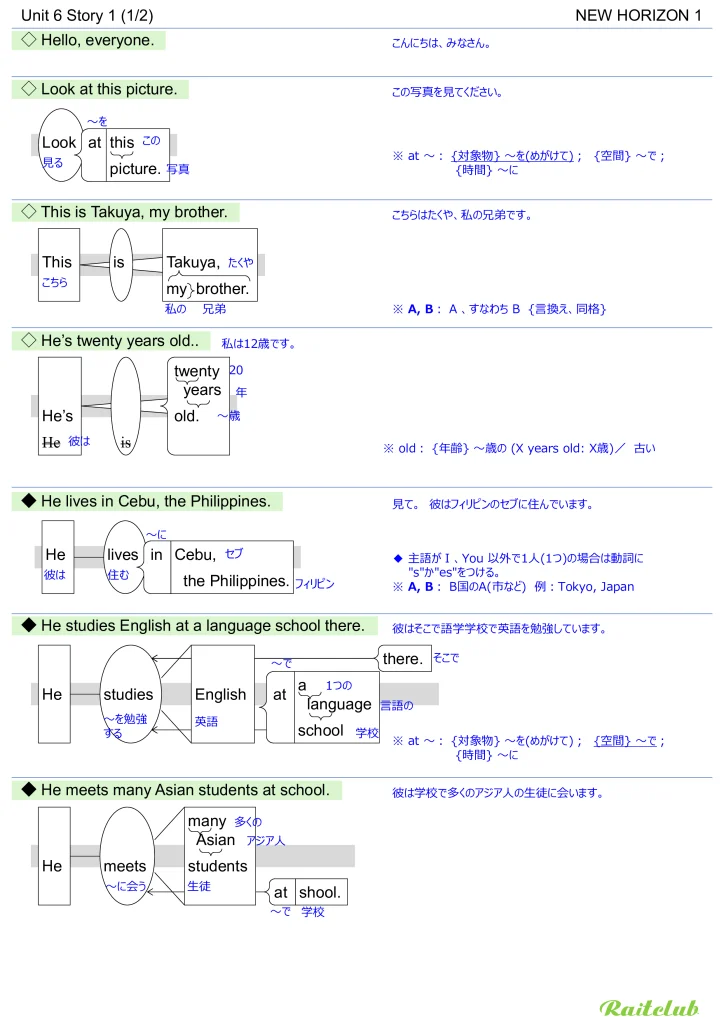
英文見える化チャート 2/2
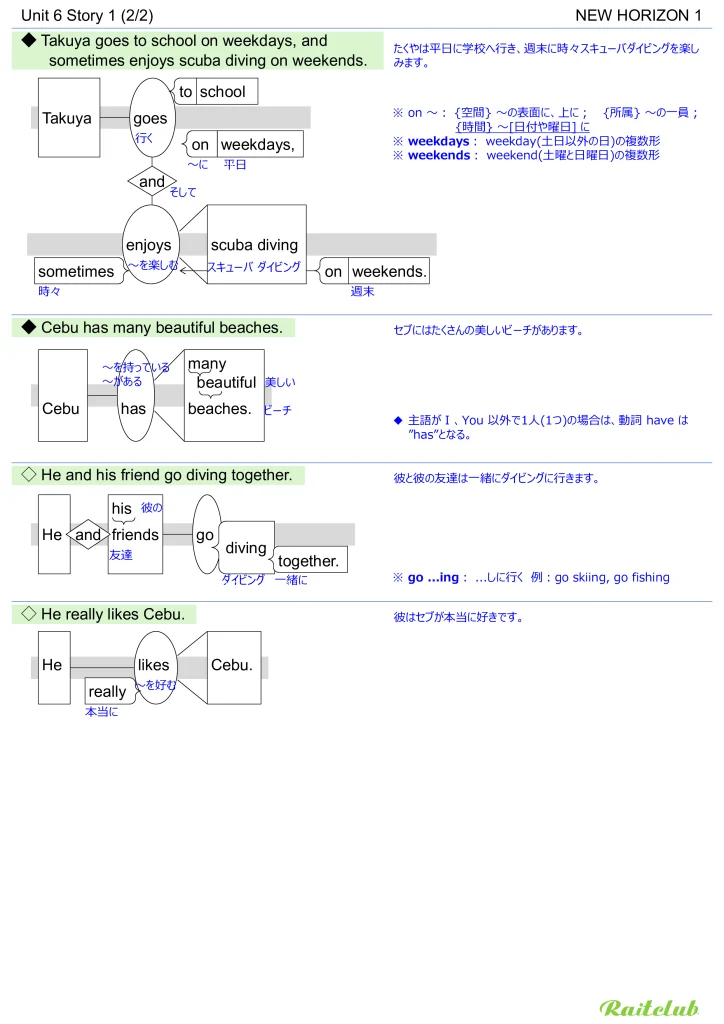
Unit 6 Story 2
◇ Takuya writes a blog about school life, local food, nature, and nice spots for diving in Cebu.
たくやはセブでの学校生活、地元の食べ物、自然、そしてダイビングにいい場所について、ブログを書きます。
※ about ~: {関連する対象} ~についての、~に関しての
※ for ~: {(関心/感情の)対象} ~にとって、~に関して
◆ He doesn’t write very often, but he gets a lot of nice comments.
彼はあまりちょくちょくは書きませんが、彼はたくさんのいいコメントをもらいます。
◆ 主語が I 、You 以外で1人(1つ)の場合は、否定文では動詞の前に”does not”を入れ、動詞に”s”や”es”はつけない。
※ doesn’t: does not の短縮形
※ {否定文での} very ~: あまり~でない
※ a lot of ~: たくさんの~
= “lots of ~”
※ of ~:{帰属先を表す} ~の; {言及された量の対象を表す}(たくさん)の~
◇ I enjoy his blog very much.
私は彼のブログをとても大いに楽しみます。
※ much: 大いに、大変/ たくさんの much money
◇ Takuya usually posts pictures on his blog, but he can’t take pictures in the sea.
たくやは通常、ブログに写真を投稿しますが、彼は海の中で写真を撮ることができません。
※ on ~: {空間} ~(の表面・上)に; {所属} ~の一員; {時間} ~[日付や曜日] に
◆ He doesn’t have a waterproof camera.
彼は防水カメラを持っていません。
◇ So he wants one.
なので彼は(1つの防水カメラを)欲しいです。
※ one: {既に言及された名詞の代りに使い} 1つ
* 実物を特定しない
参考) it: それ * 実物を特定する
◇ He really loves the beautiful sea life.
彼は美しい海の生物が本当に大好きです。
※ the X: {自然環境や日常生活の一部として誰もが知っているようなXを指したい時に the をつけて}
(その、例の)X → the は特に訳さなくてもよい
◇ Thank you.
ありがとうございます。
音声(英語/習得用)
| ♪ 英語の音声: | |
| 1回再生 | |
|---|---|
| ループ再生 | |
| ♪ 習得用の音声(英⇒日を区切りごと): | |
| 1回再生 | |
|---|---|
| ループ再生 | |
英文見える化チャート 1/2
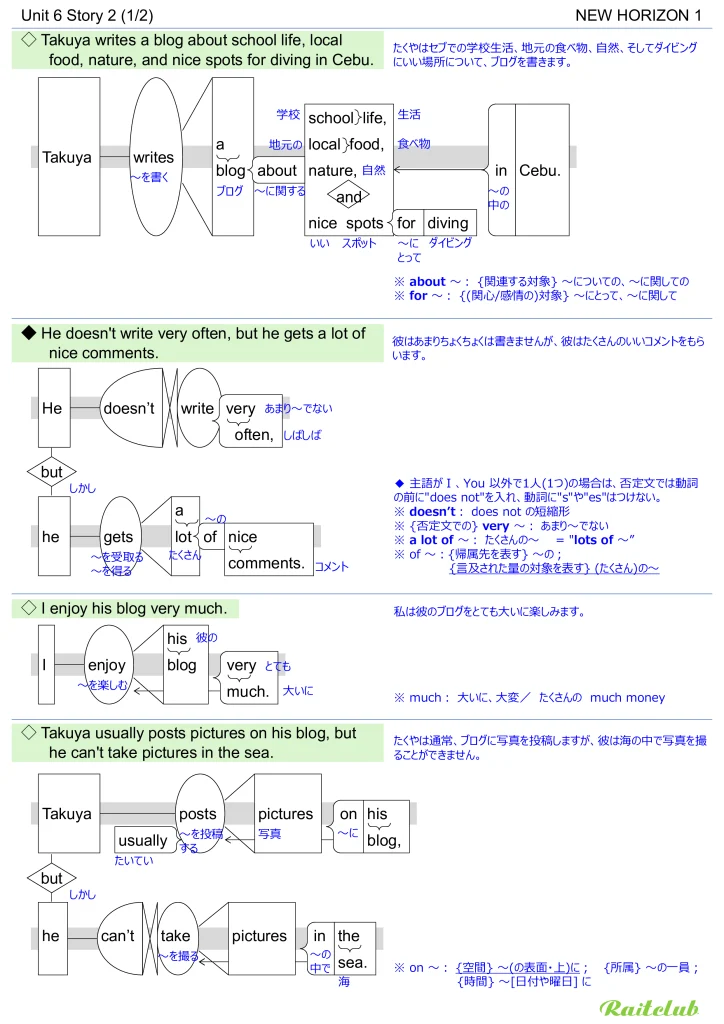
英文見える化チャート 2/2
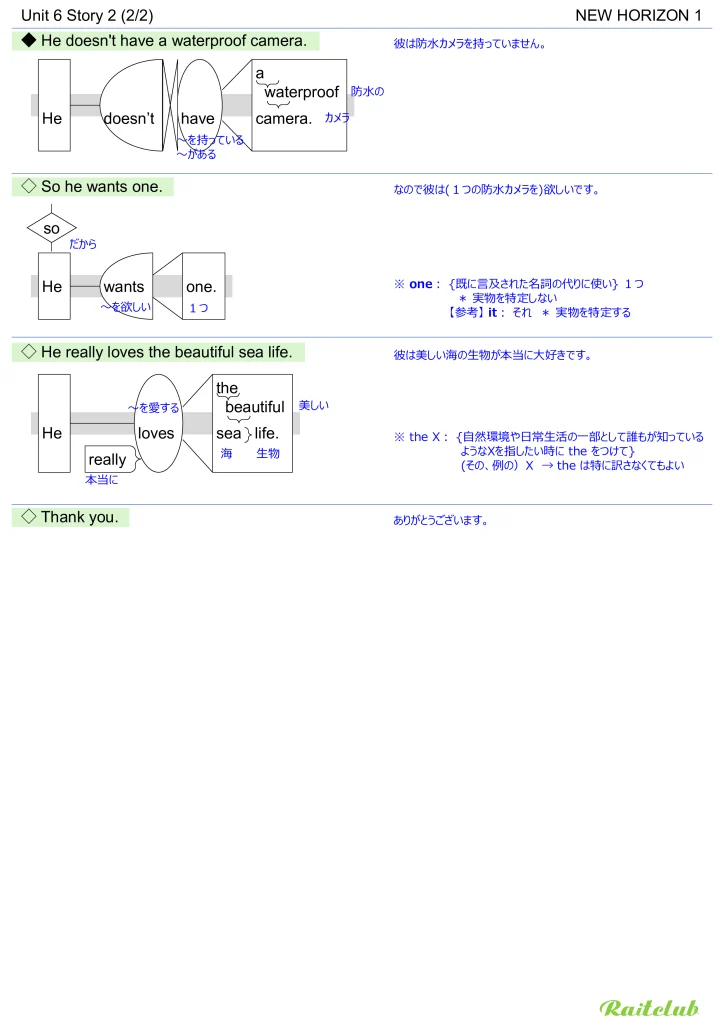
Unit 6 Story 3
◆ Does anyone have any questions?
だれか何らかの質問はありますか。
※ anyone: {疑問文で} だれか
参考) someone: {肯定文で} だれか
※ any: {疑問文で} 何らかの(1つでも)、いくらかの
参考) some: {肯定文で} いくらかの
◆ Yes. Does he like Filipino food?
はい。 彼はフィリピンの料理が好きですか。
◆ 主語が I 、You 以外で1人(1つ)の場合は、疑問文では主語の前に”does”を置き、動詞に”s”や”es”はつけない。
◆ Yes, he does.
はい、好きです。
◇ He likes sinigang.
彼はシニガンが好きです。
◇ It’s a sour soup.
それは酸っぱいスープです。
◇ Really? What does he like for dessert?
本当に? 彼はデザートには何が好きですか。
※ for ~: {相当} ~として; {(関心/感情の)対象} ~にとって、~に関して
◇ Halo-halo.
ハロハロです。
◇ It’s like a parfait.
それはパフェのようです。
※ like ~: ~のような
◇ It’s a mix of ice cream, fruit, sweet beans, shaved ice, and so on.
それはアイスクリーム、フルーツ、甘い豆、かき氷などのミックスです。
※ of ~: {中身} ~の(入った) a cup of coffee
※ and so on: など
◆ Does halo-halo mean “parfait” in Filipino?
ハロハロはフィリピン語で「パフェ」を意味しますか。
※ in ~: {手段/方法} ~[言語など]で in English
◆ No, it doesn’t.
いいえ、意味しません。
◇ It means “mix.”
それは「ミックス」を意味します。
◇ That’s interesting!
それは興味を起こさせます。 → それはおもしろいです。
音声(英語/習得用)
| ♪ 英語の音声: | |
| 1回再生 | |
|---|---|
| ループ再生 | |
| ♪ 習得用の音声(英⇒日を区切りごと): | |
| 1回再生 | |
|---|---|
| ループ再生 | |
英文見える化チャート 1/2
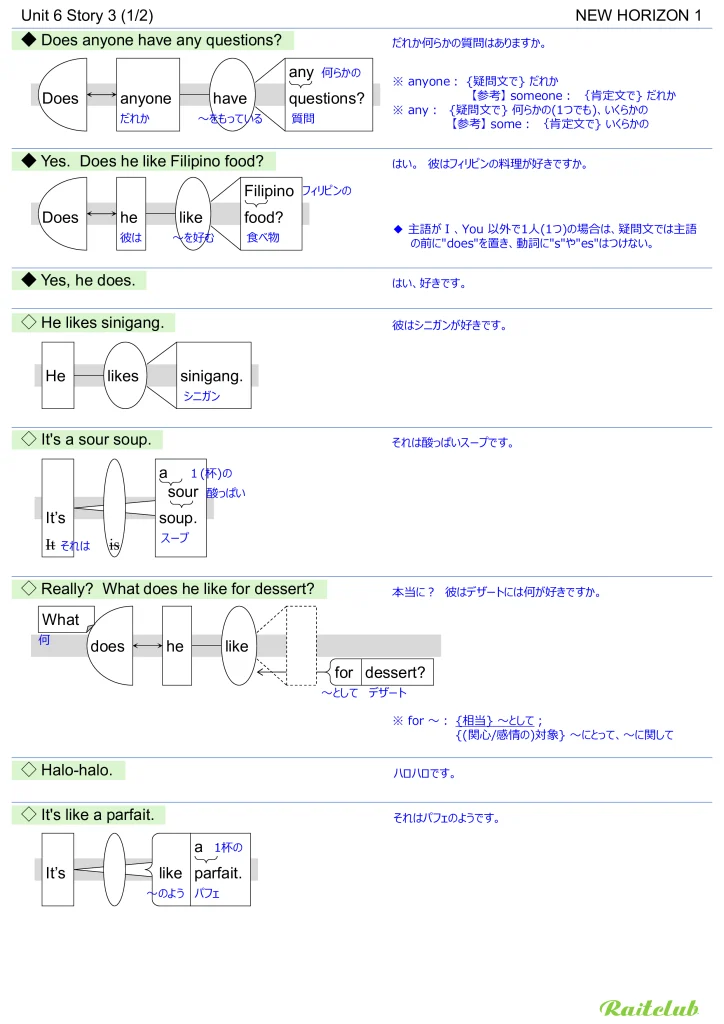
英文見える化チャート 2/2
